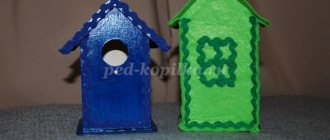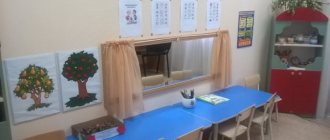About the book “Album for a speech therapist” by O. B. Inshakov
If your child has speech problems, don't worry! We'll fix everything. Speech therapist Olga Inshakova knows how to help you. The book “Album for a Speech Therapist” is an illustrated album that makes working with children much easier. The results will not take long to arrive.
The album will help track the oral speech of children and identify violations, from senior preschool to junior school age. If a child pronounces sounds incorrectly, distorts and distorts words, something needs to be done about it. You can't do it without the help of adults. Therefore, we recommend that adults read the book, and only after that work with the child.
Olga Inshakova, a specialist in her field, developed this album primarily for speech therapists in specialized and regular schools and kindergartens. If you do not have the opportunity to entrust this important task to a specialist, you can easily work with the children yourself. As you know, it is parents and grandparents who are the best example for a child.
Here is the second edition of the book with corrections and additions. The album is replete with pictures, which are very convenient to use as a visual aid.
Speech impairment is a serious problem that requires immediate correction. You shouldn’t hope for chance and wait for the child to “talk it out” himself. Olga Inshakova clearly and clearly shows how you can independently eliminate many pronunciation deficiencies.
Information is supplied in blocks. In the first part, special attention is paid to visual pictures and sounds. In the second, phonemic perception, synthesis and phonemic representation are examined. The third shows the syllabic structure of words. In the fourth, the child’s vocabulary is revealed. In the fifth, the grammatical structure is examined. In the final part, the emphasis is on independent speech.
Minor drawbacks include some outdated images, such as a corded telephone with a dial, which many children are not familiar with. But, on the other hand, you have an excellent opportunity to explain the purpose of this item in the right beautiful words, and also listen to the child’s opinion about it.
“Album for a speech therapist” should be in every home where children grow up, in every school and kindergarten. A useful treasure trove of information that you will refer to quite often. Reading such literature is not only interesting, but also useful. Good luck to you and your children!
On our website about books lifeinbooks.net you can download for free without registration or read online the book “Album for a Speech Therapist” by O. B. Inshakov in epub, fb2, txt, rtf, pdf formats for iPad, iPhone, Android and Kindle. The book will give you a lot of pleasant moments and real pleasure from reading. You can buy the full version from our partner. Also, here you will find the latest news from the literary world, learn the biography of your favorite authors. For aspiring writers, there is a separate section with useful tips and tricks, interesting articles, thanks to which you yourself can try your hand at literary crafts.
Study of sound pronunciation based on the “Album for speech therapist Inshakova.”
⇐ PreviousPage 4 of 4
1 - Andrey
2 – Alena
3 – Sveta
| WITH | wheel pine nose | 1 - kaleto, totna, note 2 - wheel, pine, nose 3 - kolefo, fofna, nof |
| With | lilac letter goose | 1 - tyren, drink, gut 2 - seat, letter, goose 3 - firen, pifimo, guf |
| 3 | castle goat star | 1 - castle, goat, star 2 - castle, goat, star 3 - castle, goat, star |
| 3 | strawberry newspaper | 1 - zemyaniya, newspaper 2 - strawberries, newspaper 3 - zamyanika, newspaper |
| w | hat cat mouse | 1 - hat, cat, mouse 2 - hat, cat, mouse 3 - fapka, kofka, myfka |
1- Andrey
1 – Alena
2 – Sveta
| WITH | wheel pine nose | 1 - kaleto, totna, note 2 - wheel, pine, nose 3 - kolefo, fofna, nof |
| WITH ' | lilac letter goose | 1 - tyren, drink, gut 2 - seat, letter, goose 3 - firen, pifimo, guf |
| 3’ | castle goat star | 1 - castle, goat, star 2 - castle, goat, star 3 - castle, goat, star |
| Z | strawberry newspaper | 1 - zemyaniya, newspaper 2 - strawberries, newspaper 3 - zamyanika, newspaper |
| w | hat cat mouse | 1 - hat, cat, mouse 2 - hat, cat, mouse 3 - fapka, kofka, myfka |
| sch | brush box raincoat | 1 - theta, yati, dress 2 - brush, box, cloak 3 - feta, yafi, plaf |
| l | boat saw table | 1 - boat, saw, table 2 - boat, saw, table 3 - ftol, loda, saw |
| l | ribbon pipe shoes | 1 - ribbon, tvire, shoes 2 - ribbon, witness, shoes 3 - lena, firel, shoes |
| R | hand cow ax | 1 - hand, cow, ax 2 - duka, kodova, ax 3 - hand, koroa, ax |
| R' | radish rope door | 1 - redita, rope, ter 2 - dediska, vedevka, door 3 - redita, rope, - |
Based on the research, conclusions were drawn in the form of tables and diagrams (see Appendix No. 1). From them it is clear that phonemic hearing is not developed, the vocabulary is very poor and sound pronunciation is impaired. It is also clear from the results of the study that all children have a large stock of nouns, but there are big problems with knowledge of other parts of speech to varying degrees. But all subjects have a main problem: ignorance of numerals (children practically do not know this part of speech). Despite all the deviations in the development of these children, they easily come into contact with both adults and children. They understand speech addressed to them well, but at an everyday level.
Conclusion.
The purpose of the work was to study the level of speech development in mentally retarded preschoolers during play activities. And the tasks are to reveal psychological and pedagogical characteristics, as well as to reveal the characteristics of speech development and the specifics of gaming activities and conduct a confirmatory experiment to identify the level of speech development of mentally retarded preschoolers. The purpose and objectives are disclosed in the theoretical and practical parts of the course work. In the first chapter
The psychological and pedagogical characteristics of a preschool child with mental retardation, concepts, causes and forms of mental retardation, features of the mental and physical development of children with mental retardation are considered. Many definitions of mental retardation are also considered, and the author considers the following to be more correct and generalized:
Mental retardation
- this is a developmental atypia in which not only the intellect suffers, but also emotions, will, behavior, and physical development. The complex structure is due, first of all, to a primary disorder that directly arose under pathogenic influence, and then to secondary deviations. That there are many classifications of mental retardation. And that during mental development there is a persistent disruption of many body functions. And that physical development is influenced by the severity of the intellectual defect, concomitant disease, and secondary disorder. And, despite the fact that mental retardation is an irreversible phenomenon, this does not mean that it cannot be corrected. The gradualism and accessibility of didactic materials during physical exercise creates the prerequisites for children to master a variety of skills for the development of physical qualities and abilities necessary in the child’s life.
The features of speech development and play activity of mentally retarded preschoolers are also considered. It is said that a mentally retarded child lags behind in speech development from the first months of life. In the future, this lag progresses even more. And by the beginning of preschool age, the child has not formed the prerequisites for speech development: objective activity, lack of interest in the environment, insufficient emotions, phonetic hearing has not been formed, and the articulatory apparatus is poorly developed. Many mentally retarded children do not begin to speak not only by preschool age, but also by four to five years. And also that in a child with mental retardation, both auditory differences and the pronunciation of words and phrases arise much later. His speech is poor and incorrect. And that one of the main reasons for this condition is the weakness of the closure cortex, the slow development of new differentiated conditioned connections in all analyzers.
It is also said that play activity is the main activity of children in preschool age and contains all development trends; she is the source of development and the creator of the zone of proximal development; behind the game there are changes in needs and changes in consciousness of a general type. It was also found that the most important aspects of the psyche, in particular the formation of a child’s personality, develop mainly in play. Thanks to it, socially accepted ethical standards of behavior are highlighted and comprehended in the mind of a preschooler, and the main driving motive of personal development is formed - to be like an adult. A new form of motives develops in the game, a transition occurs from motives that have a form to conscious, affectively colored immediate intentions.
Research by Soviet psychologists and teachers revealed the relationship between a child’s play and his mental development.
And on the basis of theoretical research, a confirmatory experiment was carried out, which was described in the second chapter of the course work. It describes the empirical basis of the study and gives characteristics of the subjects. The following is a description of the experiment itself and its results. It is said that phonemic hearing is not developed, the vocabulary is very poor and sound pronunciation is impaired. Also in the experiment it was necessary to prove the hypothesis: if we study the level of speech development in mentally retarded preschoolers, we can determine ways of correction using game exercises. As a result of the experiment, the level of speech development of mentally retarded preschool children was revealed. And thanks to the results of the study, it is now possible to determine ways of correction using game exercises. Thus, the hypothesis is proven.
In the process of studying this problem, the author of the course work learned a lot of new and interesting things: he learned what mental retardation is and its concepts, causes and forms of development, about the psychology of preschoolers, about their speech development and about the specifics of the play activity of mentally retarded preschoolers. The author also learned how to conduct a statement experiment and describe the empirical basis of the study.
Bibliography.
1..Wiseman N.P.
Psychomotor skills of mentally retarded children. – M.: Agraf, 1997.
2. Wenger L.A.
Perception and learning (preschool age) - M., 1969.
3. Vinarskaya E.N.
Early speech development of a child and the problem of defectology - M., 1979.
4. Issues of training and education of mentally retarded children. Collection of scientific papers. – M., Moscow State Pedagogical Institute named after. Lenin, 1980.
5. Raising and teaching children in a auxiliary school: A manual for teachers./ Ed. V.V. Voronkova. – M.: School – Press, 1994.
6.Vygodskaya G.L., Sokolova N.D.
On the play activities of mentally retarded children. –
"Defectology", 1974, No. 5
7. Guseva G.M.
Methodological developments on the basics of special preschool pedagogy. – M. 1983.
8.Efimenkova L.N., Sadovnikova I.N.
Formation of coherent speech in oligophrenic children. – M. 1983.
9.Zabramskaya S.D.
Psychological and pedagogical diagnostics of mental development of children. – M. Enlightenment. 1995
10..Kataeva A.A., Strebeleva A.E.
Didactic games and exercises in teaching mentally retarded preschoolers. – M., “Buk – Master”, 1993.
11. Kataeva (Wenger) A.A., Davydova S.N.
Teaching mentally retarded preschoolers in a playful way using demonstration and verbal instructions. – M., “Defectology”, 1976, No. 1
12. Kataeva A.A.
Sensory development and sensory education of abnormal preschool children. – M., 1983.
13. Correctional pedagogy: Fundamentals of training in raising children with developmental disabilities. Textbook, ed. B.N. Puzanova. – M., Publishing House, 1999.
14. Lerner D.
Oligophrenopedagogy. – Priston, 1993.
15. Speech therapy. Textbook, ed. B.N. Puzanova. – M., Publishing House, 1999.
16.Martsinovskaya E.N.
The importance of substantive and practical activities for the training and education of abnormal preschoolers. – M., “Defectology”, 1982, No. 3
17.Morozova N.G.
Formation of cognitive interests in abnormal children. – M., 1969.
18. Mahler A.R.
A child with disabilities: A book for parents. – M.: Pedagogy – Press, 1996.
19. Mukhina V.S.
Speech impairment in preschool children. – M., Education, 1969.
20. Nepomnyashchaya N.I.
The role of preschool age in the psychological development of the child // Preschool education. – 1979. – No. 7
21. Education of children with severe intellectual underdevelopment: Programs, methodological recommendations/Under. Ed. L.B. Baryaeva and others - Pskov, 1999.
22. Features of the development and education of preschool children with hearing and intelligence impairments: Sat. scientific Tr. – M., 1988.
23.Program for training and education of mentally retarded children of preschool age//Defectology. – 1986. – No. 6
24. Psychological Dictionary/Under. Ed. V.V. Davydov, A.V. Zaporozhets and others, Scientific Research Institute of General Pedagogical Psychology Academ. Ped. Sciences of the USSR. – M.: Pedagogy, – 1983.
25. Rubinshtein S.Ya.
Psychology of mentally retarded preschool children. – M.: Education, 1986.
26.Trubnikova N.M. Practical speech therapy: Educational and methodological manual / Ural. State Ped. University. - Ekaterinburg. 2002
27. Shishkova O.B. Speech therapist's album. – M., 2000.
28. Tsvetkova L.S. On the question of methods for examining children with speech underdevelopment // Defectology. – 1971. – No. 3
Application.
№1
SOUND PRONUNCIATION
| Name | sizzling | whistling | sonorans |
| Andrey | + | replacement with "T" | + |
| Alyona | + | + | |
| Sveta | replacement with "F" | - (interdentally) | + |
PHONEMATIC HEARING
| Name | whistling-hissing | voiced-voiceless | hard-soft |
| Andrey | + — (not differential whistle.) | + | — |
| Alyona | + | + — (not differential explosive) | + |
| Sveta | — | — | — |
№2
Basic, key definitions of course work:
Preschool age
– childhood period from 3 to 7 years. During this period, the processes of maturation of the child’s body take place. All major tissues and organs develop. There is a transition from activities carried out jointly with adults to activities carried out to a certain extent independently.
A game
- one of the activities of humans and animals.
Children's game
- a historically emerged type of activity, which consists in children reproducing the actions of adults and the relationships between them and aimed at understanding the surrounding reality, serving as one of the most important means of physical, mental and moral education of children.
Speech development
– Possible understanding of speech and its pronunciation at an early age when communicating with adults, subsequent enrichment of vocabulary, grammatical and stylistic structures of speech in preschool age in the process of communication and under the influence of training and education.
Speech
- a historically established form of communication between people through language.
The term “mental retardation”
denote a persistent, pronounced impairment of cognitive activity due to the diffusion of organic damage to the central nervous system.
Mental retardation
is a generalized group diagnosis for a developmental anomaly. A characteristic feature of mental development is the underdevelopment of the most differentiated phylo- and ontogenetically young functions of the brain and the relative preservation of elementary, evolutionary older ones.
Mental retardation
- this is a developmental atypia in which not only the intellect suffers, but also emotions, will, behavior, and physical development. The complex structure is due, first of all, to a primary disorder that directly arose under pathogenic influence, and then to secondary deviations.
⇐ Previous4
Recommended pages:
Use the site search:
![Visual and didactic manual on sound automation [C] “Interesting cards”](https://lubcentre.ru/wp-content/uploads/naglyadno-didakticheskoe-posobie-po-avtomatizacii-zvuka-s-interesnye-kartochki-330x140.jpg)





